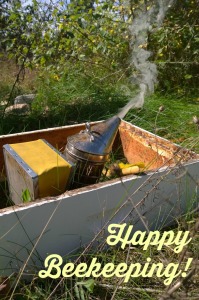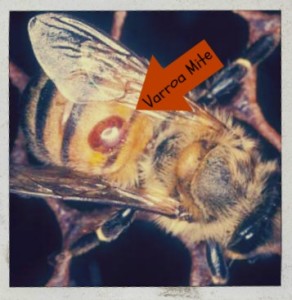Of all the things potentially killing honeybees (pesticides, poor nutrition, colony collapse), disease is one of the areas where the individual beekeeper may have some impact. Most commonly, hives are plagued with varroa mites. Varroa mites are external parasites that attack both adult honeybees and brood. They attach and suck the blood of the bee. In cases of brood infestation, bees often hatch with deformities and/or weaknesses. Left untreated, mites can ultimately kill a colony. I recently watched a video on youtube and the man said, “Are you in denial about your mite problem? Repeat after me: I HAVE A MITE PROBLEM.” If you aren’t sure if you have mites in your bee yard, you probably do. I think they are more responsible for weakened colonies than we perhaps give them credit for.
There are various treatments (both chemical-laden and natural) and many, many opinions about the treatment of varroa mites. Dr. Marla Spivak has been one of the more outspoken members of the beekeeping community who has suggested that constantly treating for mites is basically just propping up weak bees. She and her team have been working to breed mite-resistant bees since 1994. And, simply speaking, this sounds like the best solution (in my opinion), but also the most difficult. I’m encouraged by some of the work researchers are doing around the country, but as a backyard beekeeper, I need to help my colonies now. Improving the genetics of any living thing requires several generations as well as access and a bit of know-how.
This raises an interesting philosophical question about beekeeping, however. How long are we going to play the game of, what Meghan Milbrath calls, “annual beekeeping”? Every time we lose a colony in the winter and replace it with packages in the spring, we are not doing anything to help the honeybee species as a whole. Beekeepers need to start making purposeful queen selections, whenever possible. Again, easier said than done, I realize. One idea to consider is to requeen your packages with local queens – survivor stock being ideal, of course.
Another possibility is getting in touch with some of the universities who are breeding hygienic bees and see if they have queens for sale. Case in point, I signed up to be a part of the Michigan Pollinator Initiative through Michigan State University and Northern Bee Network. Last week I received an email from Dr. Meghan Milbrath explaining that Purdue University has been breeding what they call ankle-biter bees. These highly-hygienic bees actually bite the legs off the mites. They are selling queens for $150 each, provided you are willing to make upwards of 100 queens to sell or give away, so as to introduce these new traits into the local population. I find this kind of work fascinating.
There are many books, classes, and youtube videos about queen-rearing and many beekeepers who would probably be happy to show you their system (you can find many of these resources on this website, in fact). I think those of us committed to beekeeping for the long-haul need to stop propping up weak colonies and start breeding for strength. My piece of advice to you would be, don’t be afraid to fail. Do your research and give it a try. It’s time for backyard keepers to start contributing to the problem of bee deaths as well as the university researchers.
Certainly solving the varroa mite problem will not solve all of our beekeeping-woes, but it will certainly help the bees immensely if they are not fighting environmental obstacles, while also suffering from problems within the hive.
Here are some resources to check out:
Queen-Rearing Essentials by Larry Conner (a great book to get you started)
Backyard Queen Rearing with Larry Conner – an extremely thorough video about queen-rearing on a small scale.
New Direction for the Minnesota Hygienic Line of Bees – an overview of Marla Spivak’s work
An overview of Dr. Greg Hunt’s work with ankle-biter bees (includes a video of a lecture he gave about the bees and his process)
Northern Bee Network – a link to the NBN in case you are interested in contacting Meghan Milbrath for more information about the purchase of ankle-biter queens.
 To see what I’ve been up to, check out my blog at MyAdventuresInBeekeeping.wordpress.com
To see what I’ve been up to, check out my blog at MyAdventuresInBeekeeping.wordpress.com

Wonderful Informaton!
Here’s an article from National Geographic about breeding honeybees as well!
http://ngm.nationalgeographic.com/2015/05/building-bees/mann-text